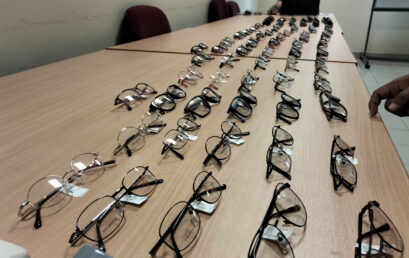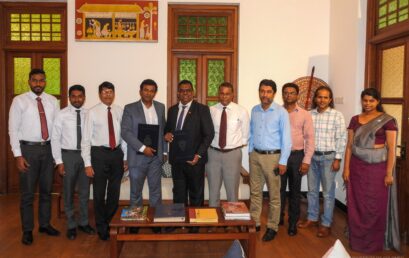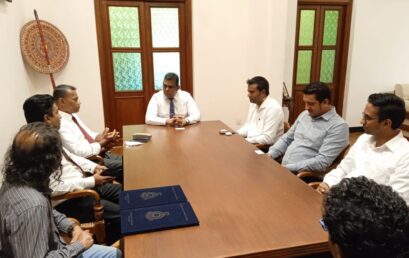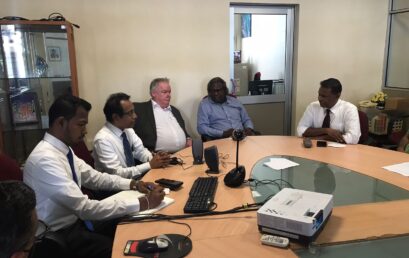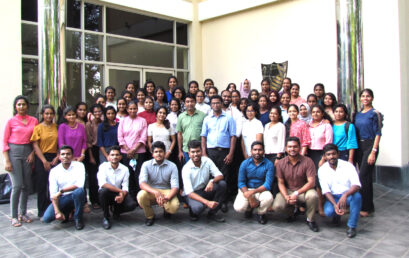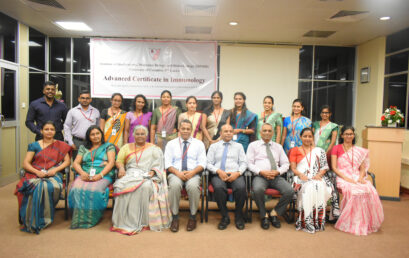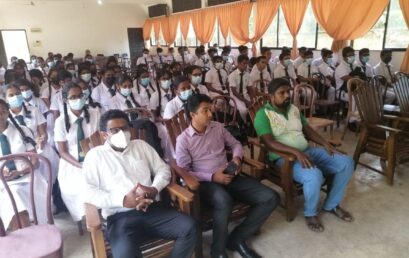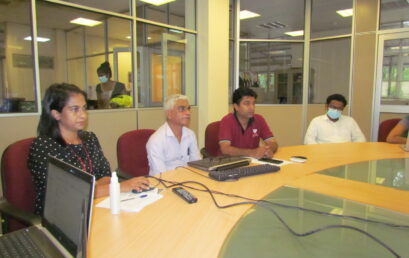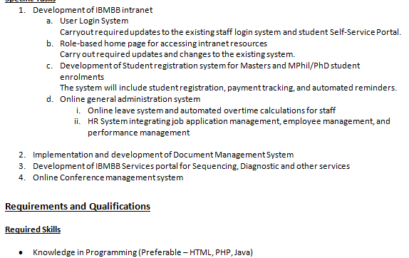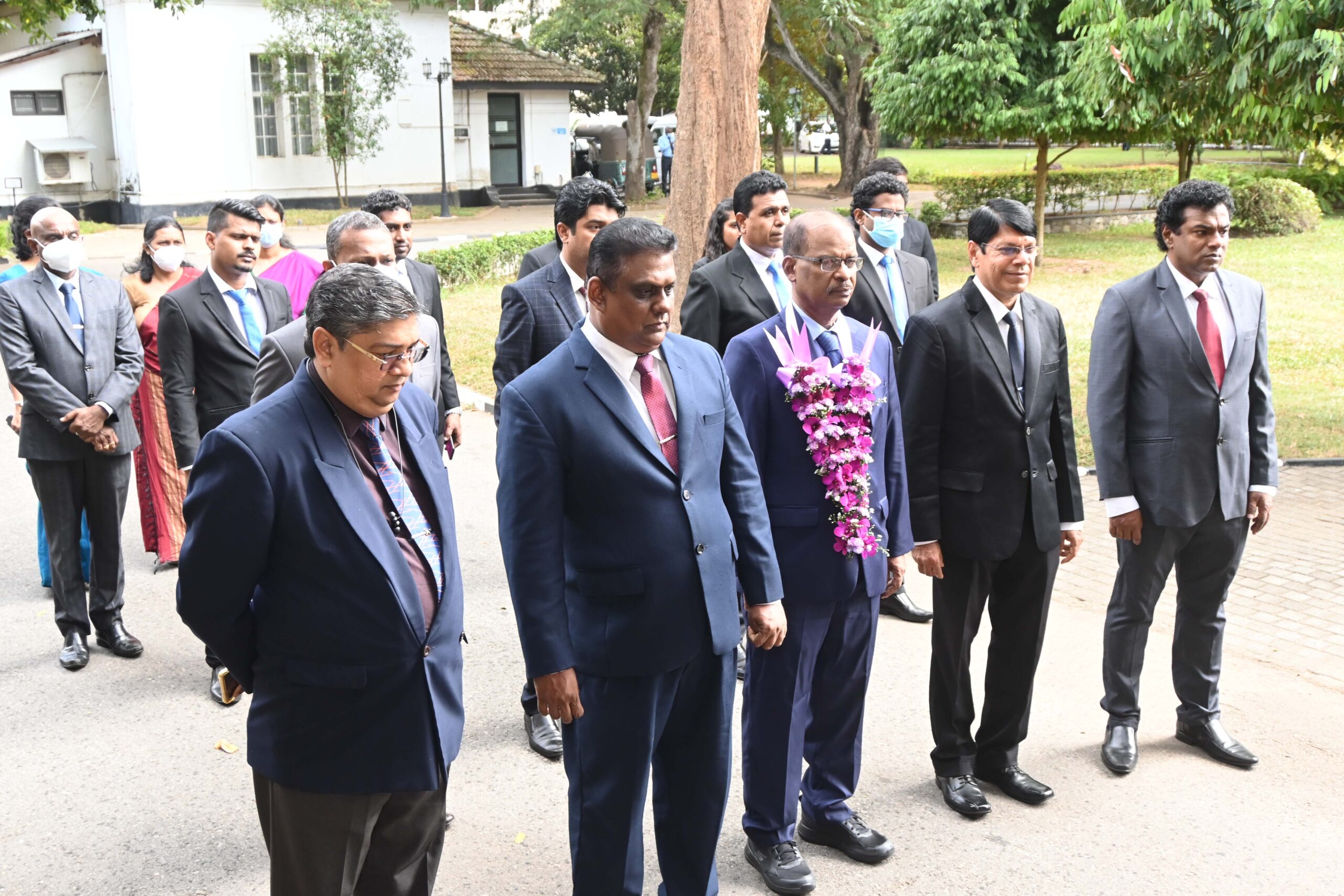Eye Checkup Camp
Eye Checkup Camp The welfare society of the IBMBB together with Spexbay Pvt Ltd. conducted an “Eye Checkup Camp” on 26th January 2023 at the IBMBB premises. Around 50 beneficiaries were screened eye disorders or diseases by a qualified Ophthalmologist. The camp was equipped with all the essential and modern medical equipment and geared to conduct a thorough eye check-up. All the staff members as well as visitors were provided with legitimate reports stating their eye health status.
Strengthening the Industry Collaborations
Strengthening the Industry Collaborations To strengthen the institution to industry concept a Memorandum of Understanding (MOU) was signed between the Institute of Biochemistry, Molecular Biology & Biotechnology (IBMBB), and Fadna Tea (Pvt) Ltd on January 17, 2023. The event took place at the College House Premises, in the presence of the Vice Chancellor Senior Professor (Chair) H.D. Karunaratne, Director of IBMBB Professor Prasanna Galhena, Professor Sameera R Samarkoon, Director of UBL Cell Professor M.N. Kaumal, Dr Kanishka Senathilake, Ms Arani Ranasinghe, and Mr Mishal Faizan, who were representing the institution. ‘Fadna Tea’ was represented by Managing Director Mr P.M. Chamendra Somathunga, Chief Product Officer Dr D.B.T. Wijerathna, Manager R&D Dr G.P.L. Supulchandra, and Executive R&D Mr S.B.C.J. Sesath Bandara. IBMBB is a renowned institution that conducts cutting-edge research in the fields of molecular biology, biochemistry, and biotechnology with subject-matter experts on staff. The goal of this collaboration between ‘Fadna Tea’ and IBMBB is to develop functional products such as nutraceuticals and to improve the quality of Sri Lankan products.
Exploring the Industrial Partnerships – “Research, Innovation and Product Development”
Exploring the Industrial Partnerships – “Research, Innovation and Product Development” A Memorandum of Understanding (MOU) was signed between the Institute of Biochemistry, Molecular Biology, and Biotechnology, University of Colombo, and LOLC Advanced Technologies PVT LTD on November 24, 2022. The event took place at the University of Colombo, College House Premises with gracing of the Vice Chancellor Senior Prof. H.D. Karunaratne, Director of IBMBB Prof. Prasanna Galhena, Prof. Sameera R Samarakoon, Director of UBL Cell Prof. M.N. Kaumal, Dr. Kanishka Senathilake, Ms. Arani Ranasinghe, and Mr. Mishal Faizan were representing the institution. LOLC Adavaced Technologies was represented by Mr. Danesh Abeyrathne the CEO of LOLC Advanced Technologies, Procurement Manager Mr. Randika Jayasinghe and Deputy Manager international Sales and Marketing Mr. Sahan Mendis. IBMBB is a renowned institution that conducts cutting-edge research in the fields of molecular biology, biochemistry, and biotechnology with subject-matter experts on staff. The goal of this partnership between LOLC Advanced Technologies and IBMBB is to create locally accessible, scientifically useful products. These programs aim to generate cutting-edge innovations that can satisfy the present socioeconomic need by producing new, enhanced products. LOLC Advanced Technologies Pvt. Ltd. is a business set up to explore sustainable business opportunities in the market with the augmentation of science and technology. It is a wholly owned subsidiary of LOLC Holdings PLC. It explores technology and innovation aligned with the country’s vision and aims to infuse local value addition. It further provides opportunities for local scientists to work on exciting projects and encourages a spirit of discovery and innovation, which are abundant in Sri Lanka.
Green Climate Fund Knuckles Project Discussion with ICRAF and IBMBB, University of Colombo
Green Climate Fund Knuckles Project Discussion with ICRAF and IBMBB, University of Colombo Dr. Fergus Sinclair visited IBMBB on December 13th, 2022, with the ICRAF and Knuckles Project teams, which included Dr. S. Premakmara, Mr. Chandana Edirisooriya, and Dr. Sirimal Premakmara, to discuss the establishment of a genomics center in Sri Lanka based on the Knuckles Project. Prof. Prasanna Galhena, along with Prof. Sameera Samarakoon, and the rest of the IBMBB staff, which includes Dr. Ruwandi, Mr. Kanchana, Mr. Mendis, Ms. Nethu, Dr. Hasitha, Ms. Joanne, and Mr. Mishal, were part of the meeting. The key areas for submission of the proposal and an expression of interest to enhance genomic exploration in Sri Lanka were discussed. As a leading institution in Sri Lanka for the Biochemistry, Molecular Biology and Biotechnology with extensive experience, a solid project idea was established for the betterment of Sri Lanka.
Wayamba University of Sri Lanka, Department of Food Sciences Visit to IBMBB
Wayamba University of Sri Lanka, Department of Food Sciences Visit to IBMBB The Department of Food Science and Technology, Faculty of Livestock, Fisheries, and Nutrition, Wayamba University of Sri Lanka, visited IBMBB, University of Colombo, on October 27, 2022. The field visit was organized for 42 students from the 3rd year based on a module conducted on the title of “Biotechnology in Food Science. They were exposed to the different types of labs, research, and equipment available at IBMBB by the academic staff and PhD students.
Continuous Professional Development (CPD) Programme
Continuous Professional Development (CPD) Programme The first Continuous Professional Development (CPD) Programme for Non- Academic Staff/ IBMBB was organized based on the Training Need Analysis. Accordingly, 6 days Training Programme was conducted under following areas. Introduction to Administrative Framework and Statutory Committees of IBMBB General Administration General Introduction to Financial Regulation, Procurement Procedures, & General Repairs, Service Agreements, Board of Survey, Losses, Write-off General Auding Procedure Disciplinary Matters, Rights and Obligations of University Employees The individual Portfolio was developed by the participants and the portfolios were assessed. The Certificates were awarded with the presence of the Registrar/ UOC and Director/ IBMBB.
Chemistry Seminar for A/L students
Chemistry Seminar for A/L Students The Dhammissara Old Pupils’ Association organized a chemistry seminar for A/L students, and Prof. Sameera R Samarakoon and Dr. Kanishka S Senathilaka from IBMBB were invited as key resource personnel. The seminar was conducted successfully, and coordination was carried out by the Business Development Unit of IBMBB.
Open Day
Open Day IBMBB had its virtual open day on October 14, 2022, with the participation of more than 100 students and researchers. The event was conducted through the Zoom platform. led by Prof. Prasanna Galhena, Prof. Shiroma Handunnetti, Prof. Jagathpriya Weerasena, Prof. Sameera Samarakoon, and Prof. Sisira Pathirana, along with the esteemed panel of academics from IBMBB, were present to introduce the MSc programs and the short courses to the participants. Additional innovative and industrial talks were given by Dr. Geethani (Head of Laboratories, Lanka Hospital Diagnostics Pvt. Ltd.), Mr. Tennakoon (Head of Research and Development, Link Natural Products Pvt. Ltd.), Mr. Chamendra (Founder, FADNA Food and Nature Pvt. Ltd.), and Dr. Muditha (Head of Research, John Keells Holdings). The proceedings concluded with a success note, and the student feedback for the event was excellent.
Short-term internship for undergraduates in the field of Information Technology
IBMBB, University of Colombo now entertain applications from competent individuals for a short-term (6 months) internship to develop a comprehensive intranet and online service portal. We are looking for a self-motivated and skilled individual who is seeking an internship as per fulfillment of his/her course requirement. You will gain comprehensive hands-on experience in the full software development lifecycle while improving your communications skills as well as developing your skills in teamwork. Job Description Routine Tasks Updating and maintenance of IBMBB Website Maintenance of the current Internet Payment Gateway Specific Tasks Development of IBMBB intranet User Login System Carryout required updates to the existing staff login system and student Self-Service Portal. Role-based home page for accessing intranet resources Carry out required updates and changes to the existing system. Development of Student registration system for Masters and MPhil/PhD student enrolments The system will include student registration, payment tracking, and automated reminders. Online general administration system Online leave system and automated overtime calculations for staff HR System integrating job application management, employee management, and performance management 2. Implementation and development of Document Management System 3. Development of IBMBB Services portal for Sequencing, Diagnostic and other services 4. Online Conference management system Requirements and Qualifications Required Skills Knowledge in Programming (Preferable – HTML, PHP, Java) Knowledge in Web Server Administration (Preferable – Apache) Knowledge of Content Management Systems (Preferable – WordPress, Moodle) Knowledge in Databases (MySql) English Language proficiency Required Qualifications Perusing/Completed a degree in Computer Science, Information Technology, or related field Experience in the IT field is not a major requirement How to Apply Written application accompanied with a brief curriculum-vitae should be sent via email (vacancies@ibmbb.cmb.ac.lk) to reach Senior Assistant Registrar/IBMBB, University of Colombo.
Nexus Between academy and industry; Product launch
Innovative product development has been one of the major focuses of the Institute of Biochemistry, Molecular Biology, and Biotechnology, the University of Colombo catering to the emerging national needs in the field of functional foods and related products. Long collaborative commitment with FADNATea (Food & Nature (Pvt) Ltd) and the Institute of Biochemistry, Molecular Biology and Biotechnology was a great success which led to the development of new products which were launched to the market on the 23rd of August 2022 at the College House, University of Colombo.This occasion was graced by Mr. Seenithamby Manoharan, Senior Rural Development Specialist, World Bank, Sri Lanka as the chief guest along with Senior Professor H. D. Karunaratne, Vice Chancellor, University of Colombo, Senior Professor Udith Jayasinghe, Vice Chancellor, the University of Wayamba as a special guest, Deans and Directors of the University of Colombo, Heads of Departments, Media representatives, Registrar and Bursar, University of Colombo, Research teams and Staff members of IBMBB. All products were commercialized under the brand name of QofL which defines the Quality of Life incorporating nature’s goodness with modern science to serve new trends for beauty and wellness. All QofL brand products are developed based on natural ingredients and scientifically proven modes of delivery to enhance the quality of the life. With the launch of the newest range of diversified products, QofL transforms this concept into an innovative solution that helps people to satisfy their ever-changing needs to live a healthier and happier life. Focusing on the three key aspects;wellness, performance enhancement, and beauty, the latest range comprises four products: SATINY, a total hair solution developed by the IBMBB; VERNOLAC a nutraceutical that enhances the quality of life for cancer patients, long-term research outcome by the IBMBB; BIO SHAPE a healthy weight management capsule improved by the IBMBB, and ORTHO-SHIELD a quick and long-lasting pain-relieving lotion specially designed for arteritis patients. The partnership with the University of Colombo strengthens the nexus between the industry and the academia, benefitting consumers in accessing value-added product rangesthat help in leading an active and happy lifestyle.Collaboration between the University of Colombo and FADNA Tea (Food and Nature (Pvt) Ltd) was supported by the University Business Linkage with the objective of transferring technologies derived from the University of Colombo into new products and services for the interest of the public. The University of Colombo being one of the leading universities in Sri Lanka has set up a platform for sustainable public-private partnerships as one of its key commitments toward the social and economic growth of the country. SATINY, with an inherent mesmerizing fragrance, developed based on the advanced aroma therapy accepted worldwide, inspireshair follicles in a biologically safer and healthier manner addressing many aspects related to the process of hair-growing. ORTHO-SHIELD, a well-refined conglomerate of natural ingredients with higher levels of pain-relieving potentials, enhances the absorption properties of active herbal ingredients stimulating and smoothening painful joints and muscles with faster and long-lasting relief effects. VERNOLAC, is a nontoxic herbal formulation developed as a nutraceutical that enhances the quality of life of cancer patients. This trailblazing nutraceutical capsule contains anti-cancer properties that help control and eliminate cancer stem cells. BIO-SHAPE also activates metabolic enzymes to enhance the fat-burning process enabling weight wellness in an effective, non-harmful, and 100% natural manner.Arresting the basics of natural metabolism and applying nature’s miraculous reactionary processes involving biologically active compounds that inhibit the excessive production of fat-forming enzymes and suppress fat formation through all-natural herbal ingredients identified and processed using advanced molecular engineering technology.
